End of Liners
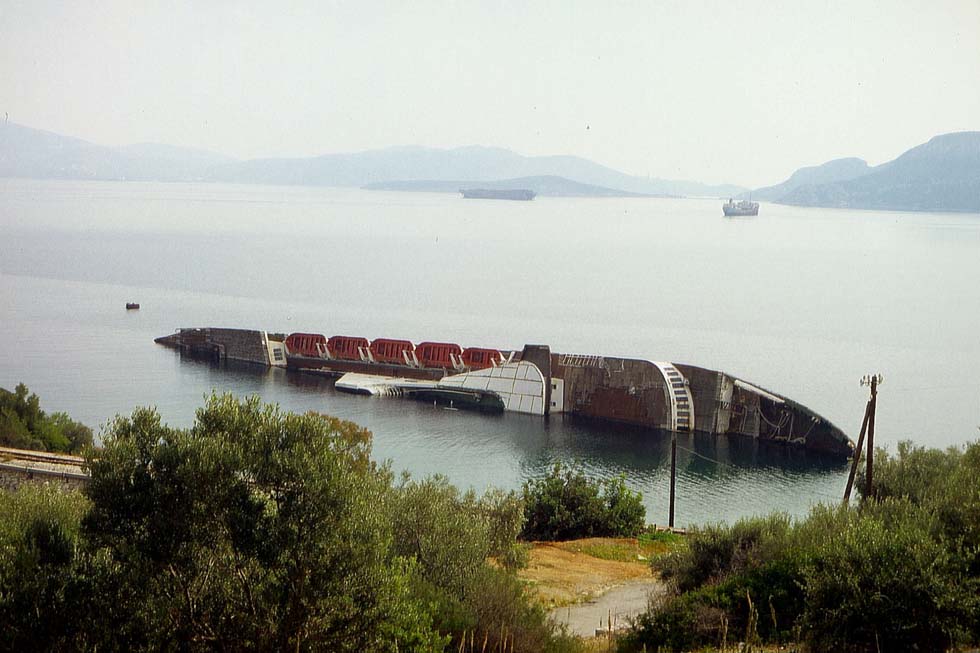
The former MS “City of York”, built in 1953 for Ellerman Lines’ London – Beira route, rebuilt as car ferry “Mediterranean Sky” and employed by Karageorgis Ancona – Patras, temporarily in Argentina as “Siterranean Sky”, laid up and in 2002 capsized at Elefsina, Greece (WS)
Start of Cruising
There are different opinions about the start of the first cruise voyage. ShipPax points out an advertisement of 1835 promoting recreational sea voyages to the Orkneys, Shetlands and Iceland. The Peninsular & Oriental (P&O) undertook a round trip from London to the Black Sea in 1843, followed by Mediterranean tours in 1844, considered by author Leonce Peillard as world’s first cruises. The renowned German shipping historian Arnold Kludas mentiond the cruising of the “Wanaka”, a steamer of the Union Steam Ship Company of New Zealand, at New Zealand’s west coast in 1877 as the first true cruise voyage. He considers however the P&O Steamer “Ceylon” of 1858, refurbished in 1881, as the first proper cruise ship. She undertook cruise voyages around Europe from 1882. Frommer’s mentioned the “St. Sunniva” of the North of Scotland, Orkney & Shetland S.N. Co as the first steamer built expressively for cruises. When the “Empress of India”, “Empress of Japan” and “Empress of China” of the Canadian Pacific were delivered at Barrow in 1891, the maiden voyages to Vancouver via the Suez Canal and Hong Kong were advertised: “Around the World in 80 days – 600 dollar”. In the same year the 7,661-ton North Atlantic liner “Augusta Victoria” of Hapag made the first cruise voyage to the Levant in order to employ her out of season. It was the idea of Hapag General Director Albert Ballin, considered by Arnold Kludas and other experts the true beginning of exclusive cruise shipping for millionaires.
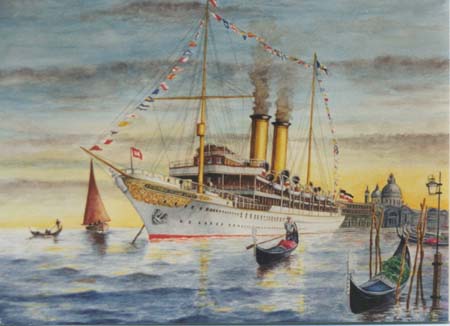 “Prinzessin Victoria Luise” of Hapag, passing Punta della Salute at Venice during a Mediterranean cruise (painting by Heribert Schroepfer)
“Prinzessin Victoria Luise” of Hapag, passing Punta della Salute at Venice during a Mediterranean cruise (painting by Heribert Schroepfer)
But which was the first vessel being specially designed for cruises only? Most experts agree with Arnold Kludas, that it has been the “Prinzessin Victoria Luise”, built at the Blohm & Voss shipyard for Hapag in 1900, named after the daughter of the German Emperor. The beautiful, yacht-styled vessel is due to an idea of Albert Ballin. Her elegant outlines, white livery and gold-decorated clipper bow, crowned by two well-proportioned buff funnels, presented a most pleasant sight. No less princess-like was her sumptuous interior. 161 crew-hands were anxious about the welfare of at most 192 board guests, who were accommodated in exclusive apartments, all fitted with heating and electric light. Tastefully furnished saloons were for dining and entertainment. Destinations of her voyages had been the Caribbean, the Mediterranean, the Black Sea and fjords of Northern Europe. The successful operation of that first real cruise ship came unexpectedly to a bad end. By daring navigation of the captain she wrecked on a reef off-shore Kingston, Jamaica. Although the ship got lost, no passenger came to harm, but the captain shot himself. Albert Ballin however let not discourage himself and started an extensive programme for cruises including a yearly round-the-world tour. New tonnage, featuring the highest standard of the time, was provided, like the 7,815-ton yacht-like “Oceana” (ex “Scot” of Union-Castle Line), the 3,613 ton “Meteor” or the 16,703-ton “Victoria Luise”, the redesigned Blue-Riband liner “Deutschland”. Other companies followed with more or less success, but none has more contributed to the development of cruise shipping as the Hapag has done. Special fame gathered in the 1930s the “Resolute” and “Reliance” (former three-funnel Atlantic liners of about 20,000 tons) and the motor ship “Milwaukee” (16,000 tons) of the Hapag or the “General von Steuben” of NDL and the more modest low-priced “Monte”-class motor ships of 14,000 tons of the Hamburg-Sued.
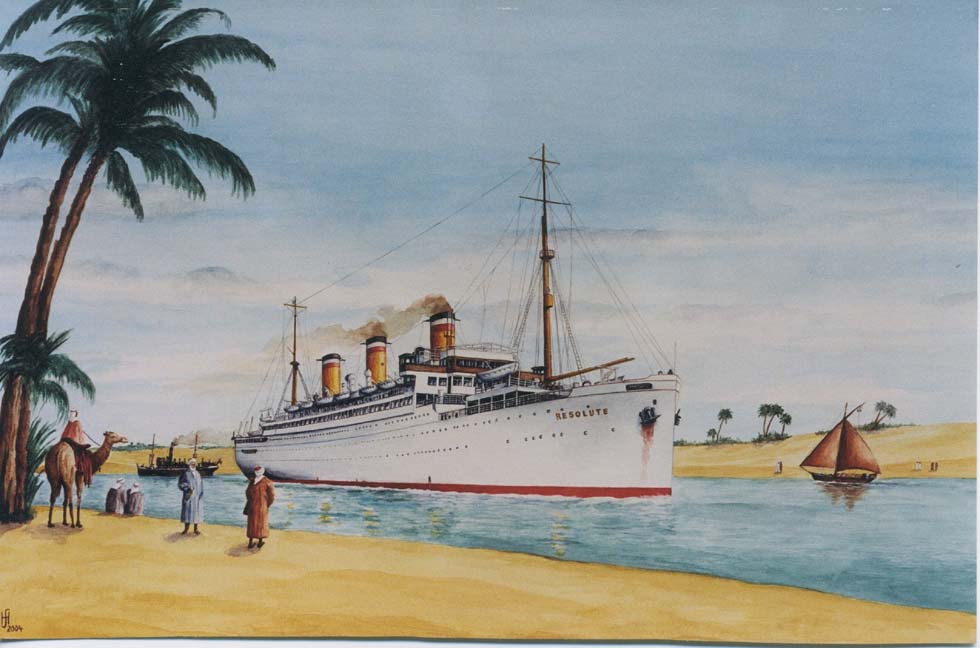
“Resolute” of Hapag on a world cruise in the 1930s passing the Suez Canal (painting by Heribert Schroepfer)
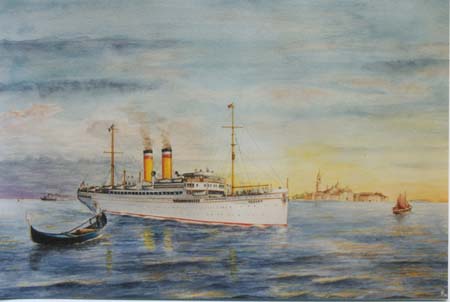
“Oceana” of Hapag, the former “Sierra Salvada”, at Venice (painting by Heribert Schroepfer)
|
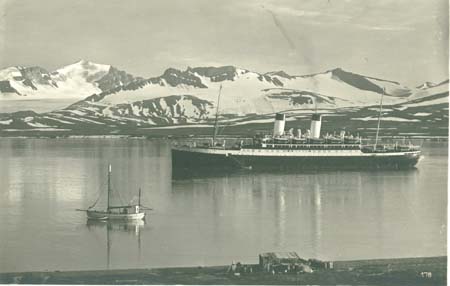
A ship of the Monte class on a cruise at Gronfjord, Spitzbergen (old card, coll. WS)
|
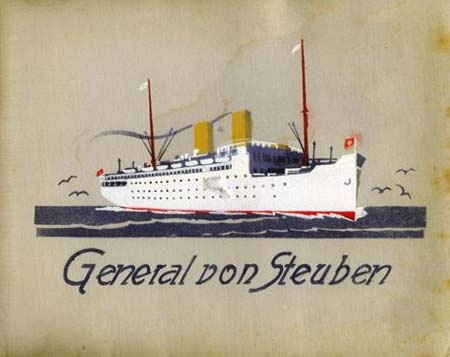
Advertisement “General von Steuben” (coll. Peter Heigl)
|
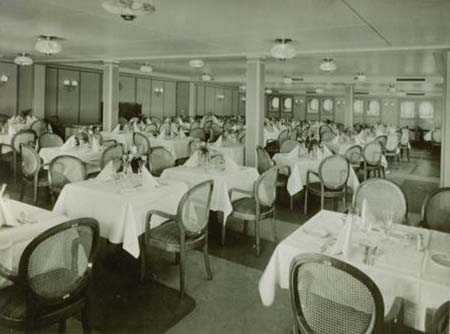
“General von Steuben” (coll. Peter Heigl)
|
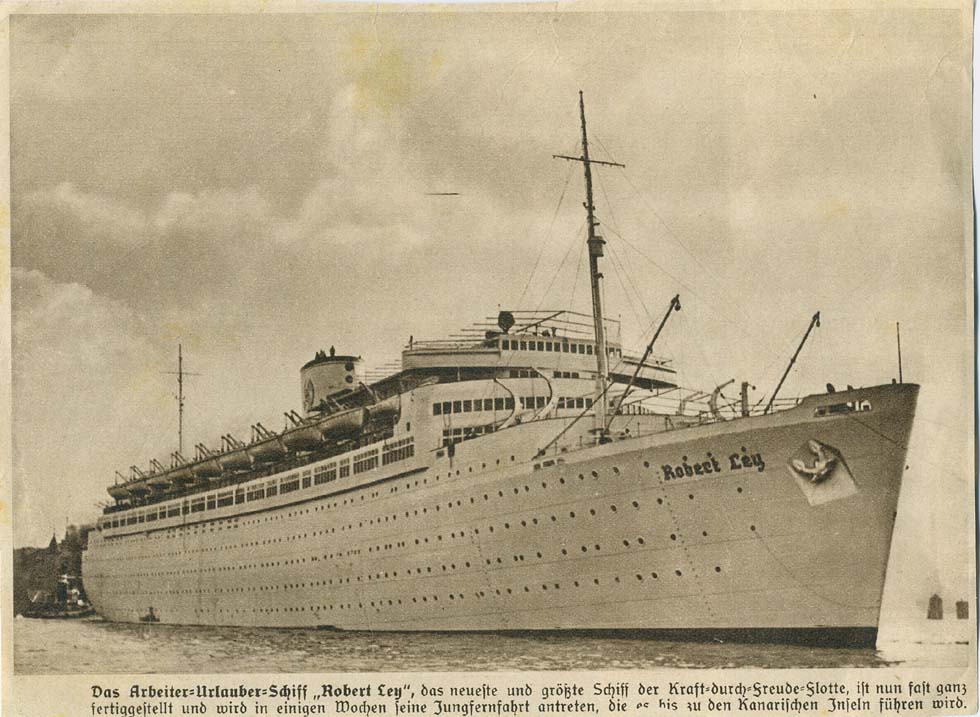
“Robert Ley” (contemporary press, coll. HSch)
An affair of its own was the touristic fleet of the “Kraft durch Freude” (KdF) organization, a branch of the Deutsche Arbeitsfront (DAF), which was called into being by the Nazi government by use of the confiscated fund of the broken up trade unions, following the aim to bind the working classes to the prevailing regime. An important step onto this way was to organize travels at a specially low fare. To make also famous sites abroad accessible, two passenger ships were chartered: From the Hamburg-Sued the MS “Monte Olivia” (13,750 gt) and from the NDL the “Dresden” (ex “Zeppelin”,14,176 gt), both refurbished as single-class ships. Only six weeks under the new brand, the “Dresden” ran on a reef in a Norwegian fjord and got lost, however without casualties. In compensation for the loss, the “Sierra Morena” (11,430 gt) was purchased from the NDL, renamed “Der Deutsche”. Following the great demand, DAF chartered another 5 ships: from the Hapag the MS “St. Louis” (16,732 gt) and the old steamer “Oceana” (8,791 gt/ 1913, ex “Sierra Salvada” of NDL, “Avare”, “Peer Gynt”, “Neptunia”) and from the NDL the steamers “Sierra Cordoba” (11,469 gt), “Stuttgart” (13,325 gt) and “Berlin” (15,286 gt). In 1935, orders for two much larger motor ships were placed with Blohm & Voss resp. Howaldtwerke Kiel, which took up service in 1938, named “Wilhelm Gustloff” (25,484 gt) and “Robert Ley” (27,288 gt). A third ship was commissioned. The “Wilhelm Gustloff” and the “General von Steuben” became subjects of great tragedies towards the end of the war, being employed with the evacuation of refugees, wounded soldiers and naval staff in the Baltic Sea. About 7,000 went down with the “Wilhelm Gustloff” and about 3,000 with the “General von Steuben”.
Of course also other countries leading in passenger shipping developed and extended the market of cruise voyages. Generally, apart from a few exceptions, mainly ocean liners became used for cruises in order to employ them out of season. From the liners’ 1st class the dressing-code of that epoch was inherited: tail coat or dinner jacket, black or white, dependent on season and region (ladies, the minority on board, always knew what to wear). Surely the most venerable old ocean liner which changed to cruises was the Blue-Riband winner “Mauretania” of Cunard, in 1935 being painted white for that purpose, carrying some of 200 millionaires, pampered with luxury.
Not in Europe, economically exhausted by military expenses and inflation, but in prosperous America regular non-subsidized shipping for tourists e.g. by Matson Line and American President Line, Furness Bermuda Line, Grace Line and by comfortable passenger-cargo vessels of the United Fruit Co. helped to spread the idea of cruising. Nevertheless the prestige of the seafaring nations was still represented by their regular ocean liners, subsidized in many cases by the national budget.
End of the Liners
With the success of jet aviation during the ‘60s, the decline of the passenger traffic at sea became evident. At the end of the ‘70s the only regular trans-oceanic routes with one-way ticketing, listed by the ABC Shipping Guide, were the round-the-world services by P&O Cruises with the “Oriana” and “Canberra” and by the USSR, offered via CTC, the North Atlantic services by Cunard with the “Queen Elizabeth 2”, Polish Ocean Lines with the “Stefan Batory”, Flagship Cruises with the “Kungsholm”, Royal Viking Line and Black Sea Shipping Co., the South America services by Costa Line and Prudential Lines, the Pacific routes by Princess Cruises and Nauru Pacific Line, and the Africa routes by CMB N.V.& Cie Maritime Zairoise, St. Helena Shipping Co., Karageorgis Lines with the “Navarino” (ex “Gripsholm”) and TFC Tours agency with the “Calypso” (ex “Southern Cross”) of Ulysses Line and, via Suez, the “Oceanos” (ex “Jean Laborde”) of Epirotiki Lines. Other services with passenger-cargo ships were irregular sailings.
Change to Tourism
At the end of the 1970s, when the number of regular trans-oceanic passenger lines had already diminished to roughly a dozen, ABC Guide to Cruises showed e.g. for the month August 1978 (apart from local trips) the number of 149 cruises from North American and Caribbean ports, 179 from European mostly Mediterranean ports (in winter much less) and 10 from Australian ports. During that month, Holland America Cruises had 19 departures, Princess Cruises and Costa each 10, Norwegian Caribbean Lines (NCL) 8, Carnival, Cunard and Home Lines each 7 departures from American ports. In Europe, Epirotiki, Sun Line (operating also for TUI), Kavounides, Chandris, the USSR, Royal Viking, Silja and Paquet Cruises, some of these companies however with small ships, and from Australian ports P&O Cruises and Sitmar had the biggest number of departures during that summer month. By nations, American and Greek companies were the leaders, followed by Dutch, British, Italian, Norwegian and Russian ones.
Some famous brands of the past survived, most ones by becoming integrated into the “big three” empires, and other labels disappeared. The latter ones are to be surveyed by the following paragraphs as far as they had a significant connection to the cruise shipping market.
North America
Renowned for their regular services to Hawaii was Matson Lines with beautiful steamers, white-painted with two funnels – the “Malolo” of 1927 (16,435 gt, later renamed “Matsonia”), the “Mariposa” II (1931/18,563 gt), the “Monterey” (1932/18,017 gt, renamed “Matsonia” II in 1957, “Lurline” III in 1963) and the “Lurline” II (1932/18,565 gt). In 1955 all services of the Matson Navigation Co. changed into cruises, but then the ships were sold and the most beautiful ones entered the fleet of Chandris. Among the smaller vessels, the “Monterey” (14,799 gt), built in 1952 for the U.S. Maritime Commission, had a remarkably turbulent career. In 1971 she was taken over by the Pacific Far East Line for cruises, in 1979 by President World Airways, in the same year by Royal Hawaiian Cruises, in 1987 by Aloha Pacific Cruises, in 1990 by Star Lauro, then MSC Cruises and in 2006 she was scrapped at Alang.
The nice “President Roosevelt” (1944/ 18,920 gt) had a turbulent career. Built for the U.S. Navy as “General W.P. Richardson”, she operated as “Laguardia” for American Export Lines, from 1956 as “Leilani” for Hawaiian SS Co., from 1962 as “President Roosevelt” for American President Lines (see chapter Pacific/ America-Orient), from 1971 as “Atlantis” for Chandris and from 1972 as “Emerald Seas” (according to Kludas for Ares Shipping Co.), from 1984 owned by Admiral Cruises, operating for Eastern Steamship Lines. The latter company provided cruises from Florida to the Caribbean and Mexico. Later the “Emerald Seas” became the “Sapphire Seas”, “Ocean Explorer I” and arrived at Alang scrapyard in 2004.
The most prominent American liner ever transferred to cruises was the “America” (26,454 gt) of the United States Lines, completed in 1940 and due to the start of WWII employed on cruises from American harbours, the first one between New York and the Caribbean, in 1941 however converted into a trooper and renamed “Westpoint”. After her resumed post-war career on the North Atlantic and acquisition by Chandris in 1964 as “Australis”, she was bought in 1978 by American Cruise Lines, undertook again as “America” the first cruise to Martha’s Wineyard, but the company under the new name Venture Cruise Lines closed down services and the “America” was sold back to Chandris in the same year as “Italis”.
The Tung group, built up by C.Y. Tung of Hong Kong, started Pacific cruises from Los Angeles in 1971 with the “Universe Campus” (13,950 gt), the former “Atlantic” of American Export Lines, before of American Banner Lines, rebuilt from a U.S. Navy freighter. In 1974 the Tung group was reported introducing the beautiful “Constitution” (20,269 gt) and her sister “Independence”, once the flagships of American Export Lines. Both ships had abandoned regular New York – Mediterranean services in 1968. A report by ‘Ferries’ informed that the laid-up “Independence” was transferred in 1974 to Atlantic Far East Lines as “Oceanic Independence”, in 1976 once again laid up. Like sister “Oceanic Constitution” she was transferred to C.Y. Tung’s American Hawaii Cruise Inc. and, according to an older report, in 1982 to American Global Line, once again as “Constitution” and “Independence”, sporting a noble white paint scheme. The companies disappeared and in 2001 the “Independence” was laid up once more. Norwegian Cruise Line bought her, renaming her “Oceanic” in 2006, but the ship was not used. After a troubled voyage for being scrapped, she sank in 2010 off the Indian coast.
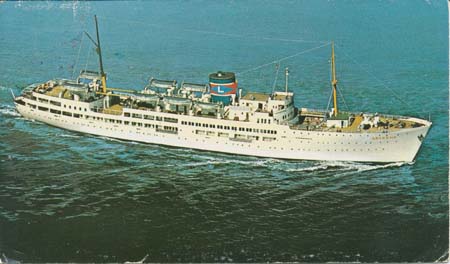
“Ariadne”, cruising for Eastern Steamship Lines from Fort Lauderdale (advertising card, coll. WS)
|
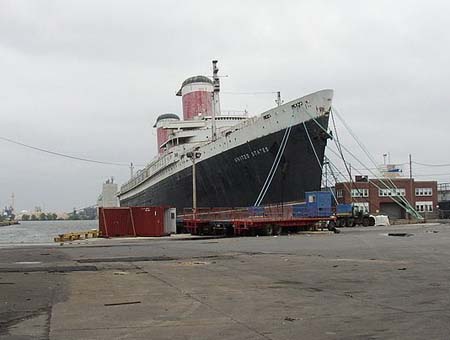
“United States” laid up (via Wikimedia)
|
America’s most prestigious liner, the “United States” of 1952, was laid up without entering the cruise business. Now it’s a rare occasion to meet somebody who has been a passenger aboard that most prestigious ship after WWII. A gentleman from Germany, who had migrated to the USA, told the stories of his Atlantic crossings with the “Italia”, the “Statendam”, the “Bremen” and with the comfortable “United States”. Of course it has been the fastest trip, the weather was very stormy, nevertheless the ship kept calm. Only when going to the upper deck, “one must pay attention for not being blown away”. According to a report by Ships Monthly (June 2013), the maximum speed achieved is believed having been 38.32 knots. In 1978 the “United States” was acquired by United States Cruises, founded by Richard Hadley for rebuilding her into a cruise ship, but financing failed. There were always dreams of saving that ultimate Blue-Riband winner, see chapter Norwegian. In 2011 the SSUnited States Conservancy bought the ship at a price of only $3 million (according to Wikipedia).
Carnival however, the biggest cruise shipping group of America and of the world has not been built up with the prestige liner “United States” of 1952, but it was the more modest former “Empress of Canada”, once the pride of Canadian Pacific or CP, which departed in 1972 as “Mardi Gras” from Miami for Ted Arison – see chapter Carnival.
England
Cunard and P&O survived with Carnival. Another famous company of the past was Royal Mail Lines, see chapter South Atlantic. Their steamer “Andes” (1939/26,435 gt) became refurbished in 1959 for cruises. She was scrapped in 1971. The Furness Bermuda Line introduced the “Ocean Monarch” (13,581 ts) in 1951 to partner their “Queen of Bermuda” (1933/22,552 gt), which was rebuilt in 1962 with one instead of the former three funnels, mainly for Caribbean cruises. Also the Union-Castle Line, famous for the African mail routes, refurbished steamers for cruises, e.g. the “Capetown Castle” (1938/27,002 gt) and the “Reina del Mar” (21,501 gt), which had been completed in 1956 for Valparaiso services. In 1963 the Travel Saving Association bought the “Reina del Mar” for cruises. Shaw, Savill and Albion had been renowned for regular round-the-world routes. Their “Ocean Monarch” (ex CP’s “Empress of England”) and the modern “Northern Star” ended cruising in 1975. The latter’s half-sister “Southern Cross” (19,313 gt) survived for decades, becoming in 1973 the “Calypso” of Ulysses Line for cruises from Greece, in 1980 the “Azure Seas” cruising in the Caribbean, then the “Ocean Breeze” and in 2003 she was scrapped. All these brands vanished – except famous Cunard and P&O.
France
The “France”, the pride of the Cie. Generale Transatlantique and with her 66,343 tons the biggest ship of the grand nation, had world’s most expensive cruise voyage in 1972 with 420 French and 500 American passengers on board, their average age being 67. Chef de cuisine Henry Le Huede had strict order to create no menu twice during the three months’ journey. However, after in 1974 the government announced to stop subsidies and labour union members captured the ship, the “France” lay idle. As the unions refused to accept a staff reduction, no French company could afford to use the “France” for cruises. In 1979 she was sold, dirt-cheap at 38 million dollars. Her story continued with Kloster, see the chapter Norwegian.
French cruise shipping became characterized by modest dual-purpose vessels such as the “Azur”, “Massalia” or “Renaissance”, motor-ships of only c. 11,000 tons, operated by Paquet Cruises. In 1982 that company introduced the “Rhapsody” (24,413 gt), the former “Statendam” of the Holland America Line, but sold her in 1986 to Regent Cruises of Greece. When Costa took control of Paquet Cruises or Croisieres Paquet in 1993, France owned no longer any cruise company with a relevant number of passengers.
Nevertheless there were ambitious dreams of a “France” successor. In 1991, when the wind-assisted “Club Med 2” was launched at Le Havre, Club Mediterrannee boss Gilbert Trigano presented the project of a liner, 240m long, laid out for 1,200 passengers, intended to cover the distance Le Havre – New York within 7 days at a speed of 21 knots, out of midsummer season to be employed in the Caribbean. It remained a dream. In 2010 Didier Spade, a French enthusiast, published the proposal of a new “France” of c.30,000gt with decks being arranged in 2 skyscraper-like funnels.
Greece
The astonishing success story of Greek cruise shipping started in 1955 with the little “Semiramis” of Epirotiki, followed in 1958 by Typaldos, first with the old steamer “Aegean”, and by Sun Line, Nomikos and by Chandris with the “Romantica”. They were small vessels of companies which then disappeared. Only Chandris Lines, famous for employing beautiful old ocean liners, survived by amalgamation with Royal Caribbean - see the chapter Celebrity ex Chandris. There were also other companies which adapted former ocean liners for cruises, but they vanished.
The Greek Line of Goulandris had introduced in 1953 the “Olympia” (22,640 gt) on North Atlantic services and for cruises. From 1974 she lay idle at Piraeus, but ten years later she re-started as “Caribe I” of Commodore Cruise Lines. In 1993 she became the “Regal Empress” and after bankruptcy of Regal she was saved in 2003 by Imperial Majesty Cruise Line of Arthur Polack, replacing the “Ocean Breeze” on Bahamas services. As in 2010 new regulations made difficult to keep this oldest ship on the U.S. market, the dream of preserving her as a floating museum in Greece emerged, but in 2009 she was scrapped. A still older steamer cruising for the Greek Line was the “Arkadia” (1931/20,648 gt), originally the “Monarch of Bermuda”. In 1963 the “Lakonia” (19,787 gt) was acquired for cruises. She has been the former “Johan van Oldenbarnevelt” of S.M. Nederland, which had cruised for Seetours (later she caught fire at Madeira). In 1964 followed the “Queen Anna Maria” (21,716 gt), formerly CP’s “Empress of Britain”. She became the “Carnivale” of Arison in 1975. She was scrapped in 2009 after her last employment as “The Topaz” for the Peaceboat Organization ended.
Home Lines, a rather international enterprise, founded by Greek entrepreneur Eugen Eugenides, had given away the “Italia” (the former “Kungsholm” of Svenska Amerika Linjen, built in 1928) and also the steamer “Atlantic” (ex “Malolo”, “Matsonia” of Matson Lines), which then became the “Queen Frederica”. For Caribbean cruises, Home Lines used the “Homeric” (18, 563 gt, ex “Mariposa” II of Matson Lines). The new elegant steamer “Oceanic” (1965/ 39,241 gt) was intended for Cuxhaven – Canada services, but then completed exclusively for cruises, equipped with an innovative ‘Magrodome’ above the pools. The ship was introduced on Bahamas services, in 1985 taken over by Premier Cruise Line as “Starship Oceanic” and in 2000 by Pullmantur. In 1973 the “Hanseatic” (ex “Shalom”) was acquired by Home Lines, renamed “Doric”, in 1981 rebuilt for Royal Cruise Line of Pericles Panagopoulos as “Royal Odyssey” and in 1988 sold to Regency Cruises as “Regent Sun”. Home Lines replaced the old ships in 1982 by the modern “Atlantic” II (19,337 gt) and in 1986 by the “Homeric” II (42,092 gt), both however being sold in 1988. The “Atlantic” was acquired by Premier Cruise Line as “Starship Atlantic” and the “Homeric” by the Holland America Line as “Westerdam”.
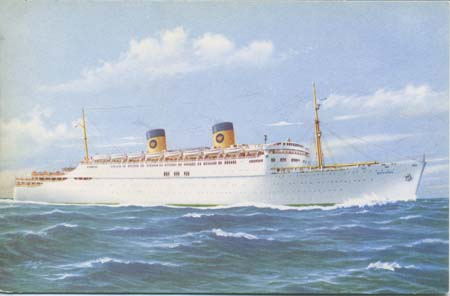
“Homeric” of Home Lines, ex “Mariposa” (II) of Matson (old card, coll. WS)
|
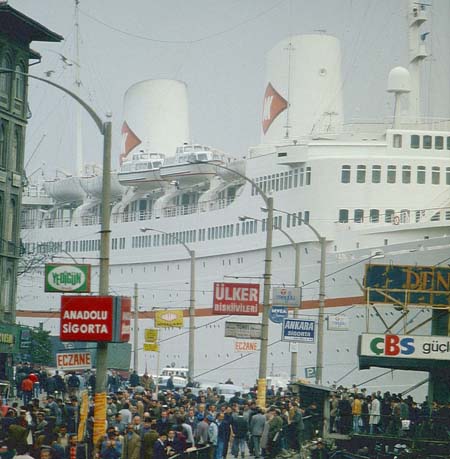
“Navarino” of Karageorgis Lines at Istanbul, 1977 (WS)
|
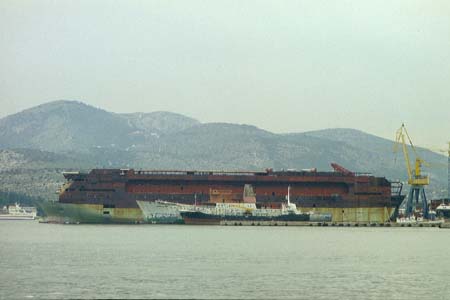 The intended rebuilt “Regent Sky” at Salamis, 2006 (WS)
The intended rebuilt “Regent Sky” at Salamis, 2006 (WS)
Karageorgis Lines of Michael A. Karageorgis acquired the beautiful “Gripsholm” II (23, 191 gt) of Svenska Amerika Linjen and used her from 1976 as “Navarino” on cruises worldwide. In 1981 she ran aground near Patmos. After fire she was considered a total loss. Finally she was bought by Antonios Lelakis of Piraeus, repaired, renamed “Regent Sea” for Regency Cruise Line, entering the U.S. market for Regent Sea Cruises, in 1987 joined by the “Regent Star” (24,294 gt), the former “Rhapsody” of Paquet Cruises, ex “Statendam” of Holland America Line. In 1982 A.E. Lelakis introduced the “Constellation”, the former “Anna Nery” of Brasil (1962/ 10,444 gt, from 1978 “Danaos” of Kavounides), after several changes in ownership becoming the “Morning Star”, then “Regent Spirit” of Regency Cruise Line, from 1996 “Salamis Glory” of Salamis Line, one of the oldest passenger ships afloat, surviving until 2009.
In 1989 Lelakis bought the unfinished ferry “Stena Baltica” from Gdynia shipyard. At Chalkis rebuilding into a 50,000-ton cruise ship “Regent Sky” was started, work was delayed, the National Bank of Greece took over, sold it, arrested it, then the uncompleted ship was registered with Liberia, tugged to Salamis Island. Some Greek press doubted if the stretched vessel ever could have attained seaworthiness. In 2008 it was removed due to environmental concerns.
After Mideast terrorism arose in the ‘80s, the American clientele, estimated 50 percent of the passengers, vanished from the Eastern Mediterranean. Fortunately enough, Epirotiki had entered the Caribbean market already in 1966. Then also Chandris, Fantasy Cruises and Sun Lines tried to survive there (for more information about Greek passenger shipping see the books by Georgeos Foustinos and by A.I. Tzamtzis).
Italy
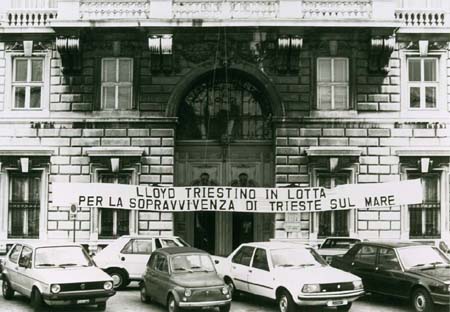 A sad story, Trieste 1984 (WS)
A sad story, Trieste 1984 (WS)
Already before WWII cruises were provided, e.g. by Lloyd Triestino with the “Lombardia” (ex “Wilhelm O’Swald”, “Resolute”), according to Weyers 1940 edition. Decades later, after a long dispute with the labour unions, the government decided in 1974 to stop almost completely the money-loosing transoceanic services of the prestigious shipping lines incorporated into the state-owned holding Finmare. In 1977 the government’s decision was revised and the “Leonardo da Vinci” (33,340 gt), “Ausonia” (11,879 gt), the “Galileo Galilei” (27,207 gt) and her sister “Guglielmo Marconi” were to maintain the cruise business in cooperation with two private companies. However, the “Leonardo da Vinci” of the state-owned Compagnia di Navigazione Italia, continuing to cause losses, had her last cruise in 1978. Hope emerged that China would buy her in order to build up a cruise shipping industry for westerners, but in 1980 she caught fire at La Spezia by unknown cause and she was written off. Italia Crociere International started cruises in 1979 with the “Ausonia”, “Galileo Galilei” and “Guglielmo Marconi”. The “Galileo Galilei” was sold in 1983 to Chandris, later renamed “Meridian”. The “Guglielmo Marconi” operated from U.S. ports and was sold in 1983 to Costa, becoming the “Costa Riviera” of the renowned Italian brand which survived with the Carnival group. The “Ausonia” of Adriatica became in the 21st century the “Ivory” of Louis Cruise Line, used in 2007 as “Aegean II” by Golden Star Cruises “in a bizarre twist”, as Ships Monthly wrote. Another traditional Italian brand to disappear was Flotta Lauro. However, it survived at least indirectly with nowadays’ famous MSC – see the relevant chapter.
Also the Sitmar Line of the Vlasov group tried to survive by changing from liner to cruises. The “Fairsea” (16, 627 gt, ex “Rio de la Plata” of Moore McCormack, completed in 1941 as the U.S. Navy escort carrier “Charger”), the “Fairstar” (21,619 gt, ex “Oxfordshire” of Bibby Line), the “Fairland”, then “Fairsea” (II, 21,916 gt, ex “Carinthia” of Cunard) and the “Fairwind” (ex “Sylvania” of Cunard) entered that business, operating also from U.S. and Australian ports. In 1984 the “Fairsky”, a beautiful new cruise ship of 46,087 tons, joined the fleet, but in 1988 Sitmar Cruises had to be sold to the P&O group. The label was withdrawn and P&O obviously lost the chance to enter the Italian market. The activities of the pioneers’ families continued with Silversea Cruises – see the chapter Highlights and Attempts.
Norway
The Norwegian America Line or Norske Amerikalinje employed its relatively new diesel-powered trans-Atlantic liners “Oslofjord” (16,923 gt), “Bergensfjord” (18,739 gt) and “Sagafjord” (24,002 gt) out of season on cruises. The “Vistafjord” (1973/ 24,292 gt) was from the beginning famous for luxurious round-the-world cruises. In 1970 the company founded together with two other enterprises the Royal Viking Line, which was acquired by Norwegian Caribbean Lines – see the chapter Norwegian & Kloster. Towards the end of the ‘70s, ABC Shipping Guide showed the “Sagafjord” of the Norwegian America Line cruising from U.S. ports. In 1980 the fleet was transferred to Norwegian American Cruises. Three years later Cunard took over the enterprise as Cunard/NAC and soon the “Norwegian” label was dropped – see the chapter Cunard Line. The “Sagafjord” and half-sister “Vistafjord” survived the turn of the century as “Saga Rose” and “Saga Ruby” of the Saga Shipping Co.
Sweden
Also Swedish ocean liners changed to cruises and the services of Svenska Amerika Linjen disappeared. A curious fate had the Swedish “Stockholm” of 1948, which had rammed the “Andrea Doria” in 1959. She survived after serving as “Voelkerfreundschaft”, then “Volker”, “Fridtjof Nansen”, “Italia I”, “Italia Prima”, “Valtur Prima” (for Cuba cruises), “Caribe” and from 2004 as “Athena” (of Lisbon-based Greek ship-owner George Potamianos’ Classic International Cruises), “Vision Athena” (of Vision Cruceros), “Athena” (of Mediterranean Classic Cruises). The “Kungsholm” of 1953 (21,514gt) got famous in 1965 as “Europa” of Norddeutscher Lloyd, in 1981 changing to Costa as “Columbus C”. The fourth “Kungsholm” (1966/ 28,891 gt) had a turbulent career, her most spectacular scenes being the millennium cruise around Africa for P&O as “Victoria”, her appearance as “Mona Lisa” for Holiday Kreuzfahrten, then as “Oceanic II”, ‘The Scholar Ship’, once again as “Mona Lisa” with the famous funnel paint and temporarily she arouse as ‘The Peace Boat’. The Swedish entrepreneur Lars Hallgren had developed the plan to save her as a hotel and museum ship at Gothenburg, but in 2010 the failure of the project was reported. In 2012 the enthusiasts were enjoyed to learn that the nice ship was not scrapped, but has become the hotel ship “Veronica” at Duqm in Oman, in 2013 however replaced by a hotel ashore.
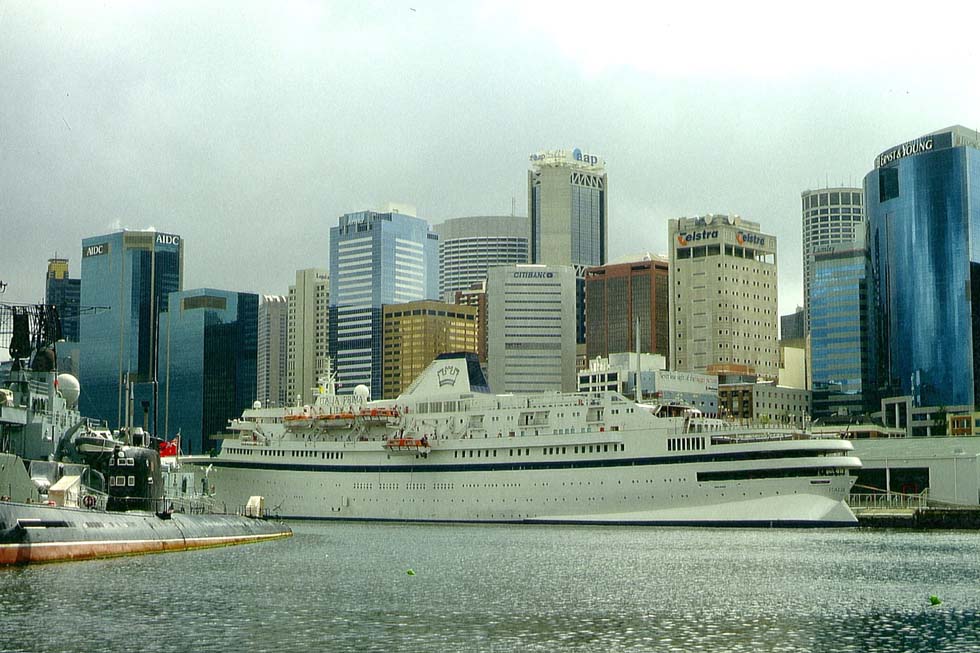
“Italia Prima”, the rebuilt former “Stockholm” of 1948, at Sydney 1997 (WS)
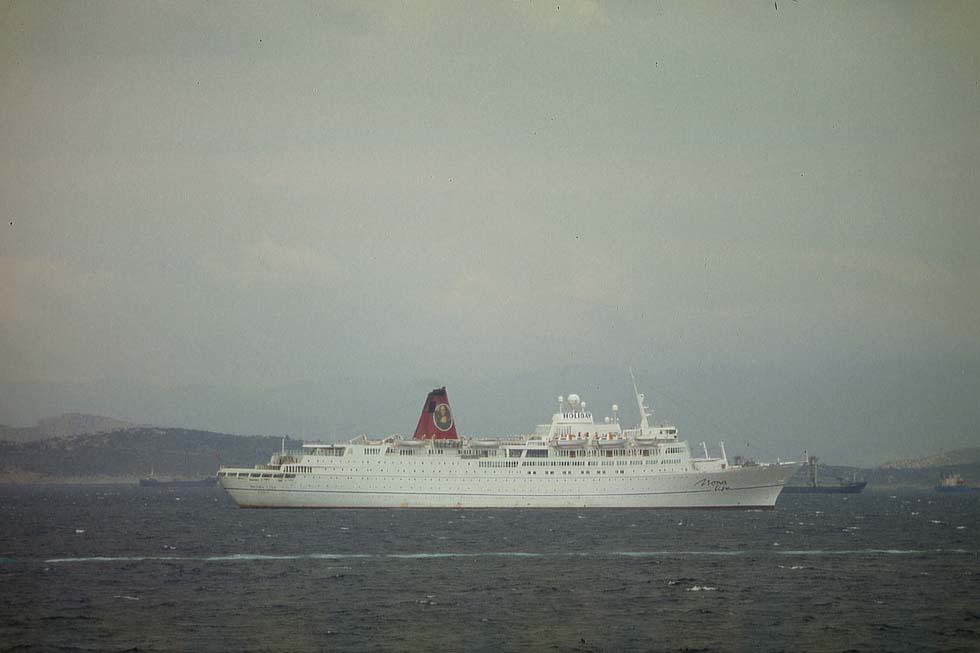
“Mona Lisa”, the former “Kungsholm” of 1966, at Salamis 2006 (WS)
Soviet Union
The Soviets provided cruises in the Black Sea with the “Admiral Nakhimov”, the rebuilt ex-German pre-war “Berlin”. A ‘Vladivostok-Equator’ cruise itinerary was opened in 1966 with the “Russ”, the ex-German “Cordillera”. The nice 20,000-ton diesel-powered ocean liners “Ivan Franko”, “Aleksandr Pushkin”, “Mikhail Lermontov”, “Taras Shevchenko” and “Shota Rustaveli” of the so-called ‘Five Poets’ class, built in East Germany between 1964 and 1967, were from the beginning used also for cruises, then being painted white instead of black/white. They were joined in 1973 by the “Fedor Shalyapin” the former “Franconia” and the “Leonid Sobinov”, the former “Carmania”, both of Cunard. In 1975 the 13,758-ton “Odessa”, originally launched as “Copenhagen” for Nordline, joined the Black Sea fleet for cruises. Also the 16,631-ton “Belorussiya”-class motor-ships, built in Finland in 1975-76, were used mostly for cruises. The “Hamburg”, then “Hanseatic”(III) of Deutsche Atlantik Linie became in 1974 the “Maksim Gorkiy” of the Black Sea Shipping Co. In 1989 she made headlines when she rammed ice near Spitzbergen. Passengers were rescued by coast guard and helicopters and the ship was repaired. In December of the same year the presidents George Bush and Mikhail Gorbachev had their summit aboard the “Maksim Gorkiy” at Malta. The “Mikhail Lermontov” sank in 1986 in the Cook Strait of New Zealand. The “Fedor Dostoevskiy “ (20,606 gt), acquired in 1988 by the Black Sea Shipping Co., had been the second “Astor” of Safmarine.
The Russian ships were successful, nevertheless the former Soviet label disappeared from the oceans when the Soviet Union was dissolved in late 1991. The “Aleksandr Pushkin” became the “Marco Polo” of Orient Lines (see chapter Star Cruises). The “Maksim Gorkiy” continued her career after 1991 as “Maxim Gorki”, operating for Phoenix Reisen as before, until 2008. Also some smaller ships changed to cruising for foreign companies and the service was ameliorated by employing catering companies. With the end of the state-owned fleet, passenger shipping of mighty Russia had vanished in an odd way, difficult to trace the reasons.
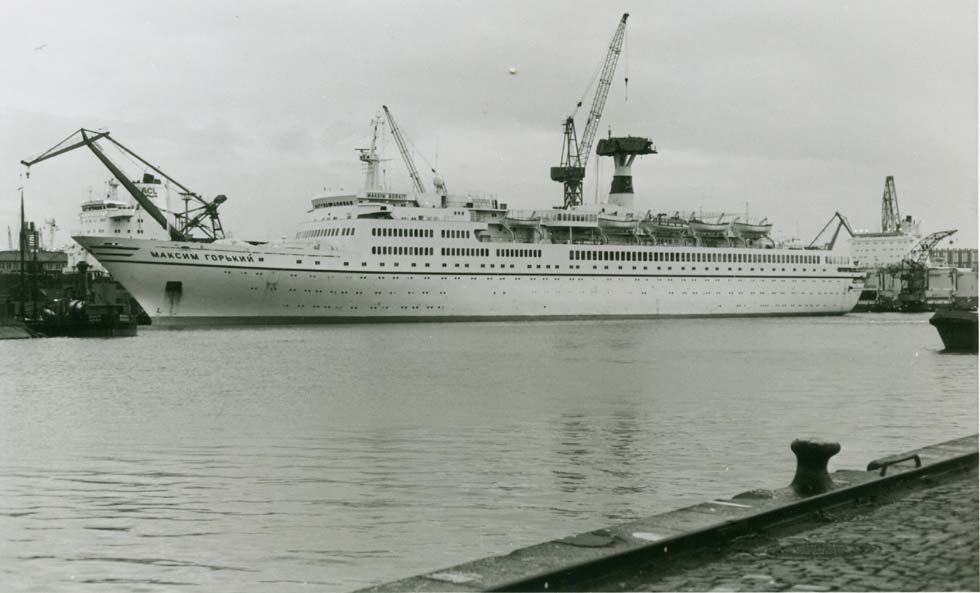
“Maksim Gorkiy”, being refurbished at Lloyd-Werft, Bremerhaven 1982 (WS)
China
Also Chinese ocean liners changed to cruises. Among the passenger-cargo motor ships of the China Ocean Shipping Co., which had been employed on East Africa, than East Asia routes, the “Yao Hua” (1967/ 10,151 gt) undertook from 1983 cruises on the Yangtsekiang and along the Chinese coast, until she was sold in 1986 as the “Orient Princess”. The “Ming Hua” (14,442 gt, ex “Ancerville”, cruised for some time from Australia for Burns, Philp & Co., before she became preserved at Shenkou (information by Arnold Kludas).
Proud Companies
English pride survived with Cunard and P&O, Italian with Costa and MSC, Dutch with the Holland America Line, Greek with Celebrity and German tradition with Hapag-Lloyd - see the relevant chapters. Polish Ocean Lines had replaced the classic “Batory” of 1936 with the “Stefan Batory” (15,044 gt), the former “Maasdam”, of Holland America Line. Hundreds of Polish citizens used her cruises for escaping from communism for ever, in 1988 she was sold and passenger services ended. Nippon Yusen Kaisha of Japan restarted by entering initially the luxury market with Crystal Cruises. Passenger services of other national icons, such as Compania Trasatlantica of Spain, Cia. Portuguesa de Transportes Maritimos or Zim Lines, disappeared completely.
|